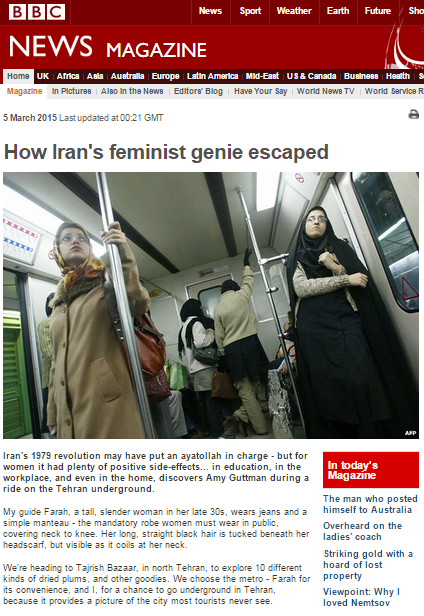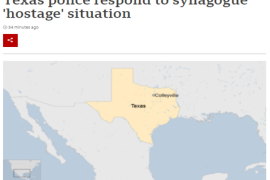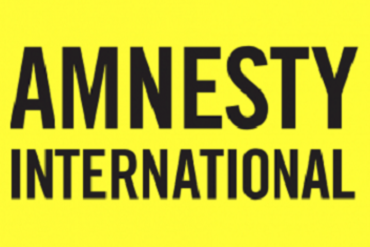This is what Freedom House had to say about the status of women in Iran in 2014:
“A woman cannot obtain a passport without the permission of her husband or a male relative. Women are widely educated; a majority of university students are female. They are nevertheless excluded from most leadership roles. Women currently hold just 3 percent of the seats in the parliament, and they are routinely barred from running for higher office. Female judges may not issue final verdicts. Women do not enjoy equal rights under Sharia-based statutes governing divorce, inheritance, and child custody, though some of these inequalities are accompanied by greater familial and financial obligations for men. A woman’s testimony in court is given only half the weight of a man’s, and the monetary compensation awarded to a female victim’s family upon her death is half that owed to the family of a male victim. Women must conform to strict dress codes and are segregated from men in some public places.”
These are excerpts from the UN Secretary General’s review of human rights in Iran published last month:
“…women only account for 16 per cent of the labour force. According to the Global Gender Gap Index for 2014 of the World Economic Forum, the Islamic Republic of Iran ranked no. 137 out of 142 countries. Furthermore, men earn 4.8 times more than women. With regard to women in ministerial positions, the Index ranked the Islamic Republic of Iran no. 105 out of 142 countries, and there are few women in managerial or decision-making roles […]. The draft comprehensive population and family excellence plan, reportedly currently being considered by parliament, would further restrict the participation of women in the labour force. Preference for employment opportunities would be given, in order, to men with children, men without children, then lastly to women with children. Furthermore, teaching positions in higher education and research institutions would be reserved for qualified married applicants.
According to article 1117 of the Civil Code, a husband may prevent his wife from occupations or technical work deemed incompatible with family interests or his own dignity or that of his wife. The law may even prevent women from pursuing artistic activities.
…child marriage remains prevalent in the country. The legal age of marriage for girls is only 13, and some as young as 9 years of age may be married with the permission of the court. In 2011, about 48,580 girls between the age of 10 and 14 were married; and in 2012, there were at least 1,537 girls under the age of 10 who were reportedly married.
…laws continue to allow for marital or spousal rape and discriminate between men and women with regard to the spouse’s ability to initiate and complete divorce. A woman is required to prove that a significant threat has been made to her life in order to be able to file for divorce. Such laws make it difficult for women to escape domestic violence and to protect themselves from any real and immediate risk to life or integrity.
Nationality laws in the Islamic Republic of Iran do not grant women equal rights when transferring their nationality to their children.
Women in the Islamic Republic of Iran are required to observe Islamic dress code in public places. The parliament reportedly recently approved a plan “on the protection of promoters of virtue and preventers of vice”, which would increase checks on improper veiling. […] The morality police strictly monitor all public places, including vehicles, and take action against those who do not adhere to the morality codes. Women who appear without an Islamic hijab risk arrest and imprisonment of between 10 days and two months, or a fine of up to 500,000 rials. Approximately 30,000 women were reportedly arrested between 2003 and 2013, with many others subjected to expulsion from university or banned from entering public spaces, such as parks, cinemas, sport facilities, airports and beaches.”
This is the opening paragraph of an article titled “How Iran’s feminist genie escaped” which was published in the ‘Features & Analysis’ section of the BBC News website’s Middle East page and in its ‘Magazine’ section on March 5th – in decidedly embarrassing proximity to International Women’s Day:
“Iran’s 1979 revolution may have put an ayatollah in charge – but for women it had plenty of positive side-effects… in education, in the workplace, and even in the home, discovers Amy Guttman during a ride on the Tehran underground.”
Later on in the article, readers are told:
“Farah talks of the major changes Iranian women have experienced in the last 30 years […] On Tehran’s metro, I’m getting a spontaneous, unprompted lesson about gender equality in Iran.
Farah tells me it all began, not with imports from the West, but with the 1979 revolution. A confluence of access, education and a bad economy created a society where women now have independence, careers and husbands happy to help around the house with chores and children.
The revolution, Farah says, was very good for women.”
The article continues:
“The revolutionists supported women coming out of their homes to demonstrate. They used women to show their strength, but they never anticipated these women also believed in their right to exist outside the home,” Farah remembers.
Iran’s genies were let out of the bottle. The same genies have gone on to become active members of theological schools and hold positions as judges and engineers. […]
There’s no greater evidence of women in the workplace, than where we’re sitting, surrounded by women on their way to work. It’s another outcome the Ayatollah hadn’t expected, but with Iran’s economy battered by the revolution, women had no choice but to join the workforce.
“It forced men to acknowledge that their wives could go out and earn money,” Farah says. Growing up, Farah only remembers affluent families allowing girls to work outside the home. Now, she says, “Nearly all boys prefer to marry a girl who has a permanent job and good salary. Often the women work harder, and longer hours than their husbands, so they do more of the housework – cleaning and preparing meals.””
Of course the rosy picture painted by Amy Guttman’s sole source for this article – whom she economically describes as “my guide Farah” – is clearly at odds with the reality presented in reports such as those above. So who is Farah and why is her portrayal of the status of women in Iran so different from the accounts of numerous human rights organisations?
Amy Guttman is a freelance journalist and in addition to this article and the very similar audio version (from 11:22) made for the February 28th edition of BBC Radio 4’s ‘From Our Own Correspondent’, her visit to Iran also prompted pieces for other media outlets. In one of those articles she correctly notes that:
“British, American and Canadian tourists must be accompanied by a guide at all times in Iran.”
Those guides must be approved by the Iranian Foreign Ministry. In other words, the sole source for the BBC’s multi-platform promotion of the notion that the 1979 Islamic revolution in Iran was “very good for women” is a regime approved minder.
And yet that fact did not prevent the organization which likes to describe itself as “the standard-setter for international journalism” from commissioning, publishing and broadcasting this cringingly transparent regime propaganda which whitewashes the serious issues faced by women in Iran.




